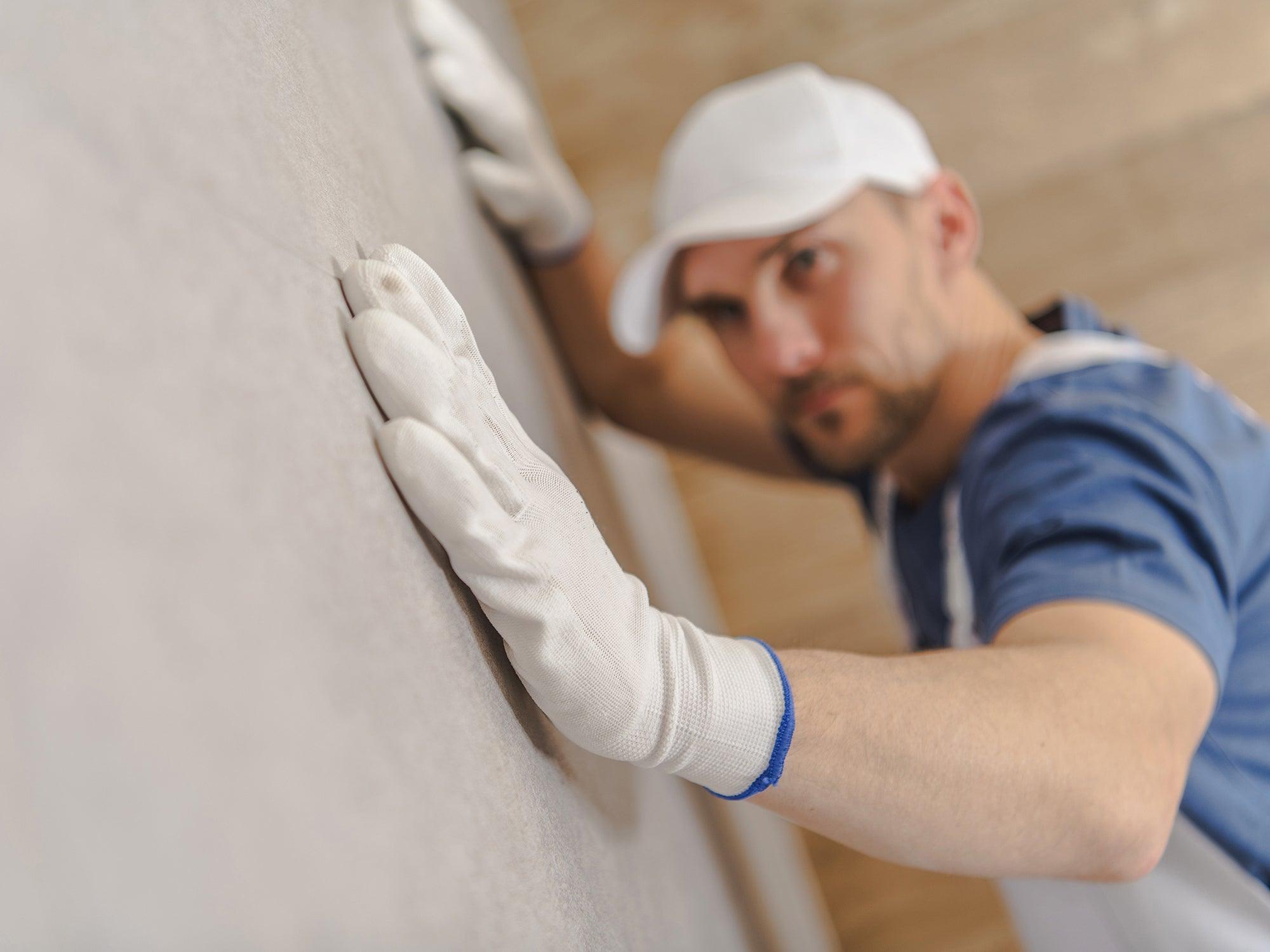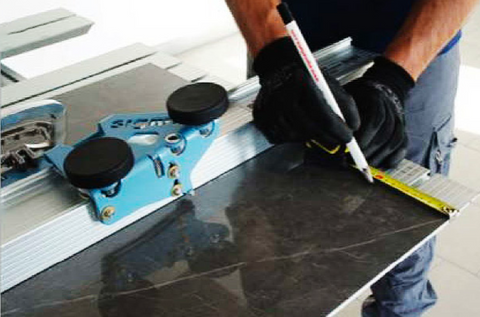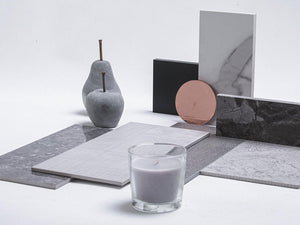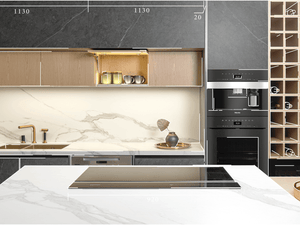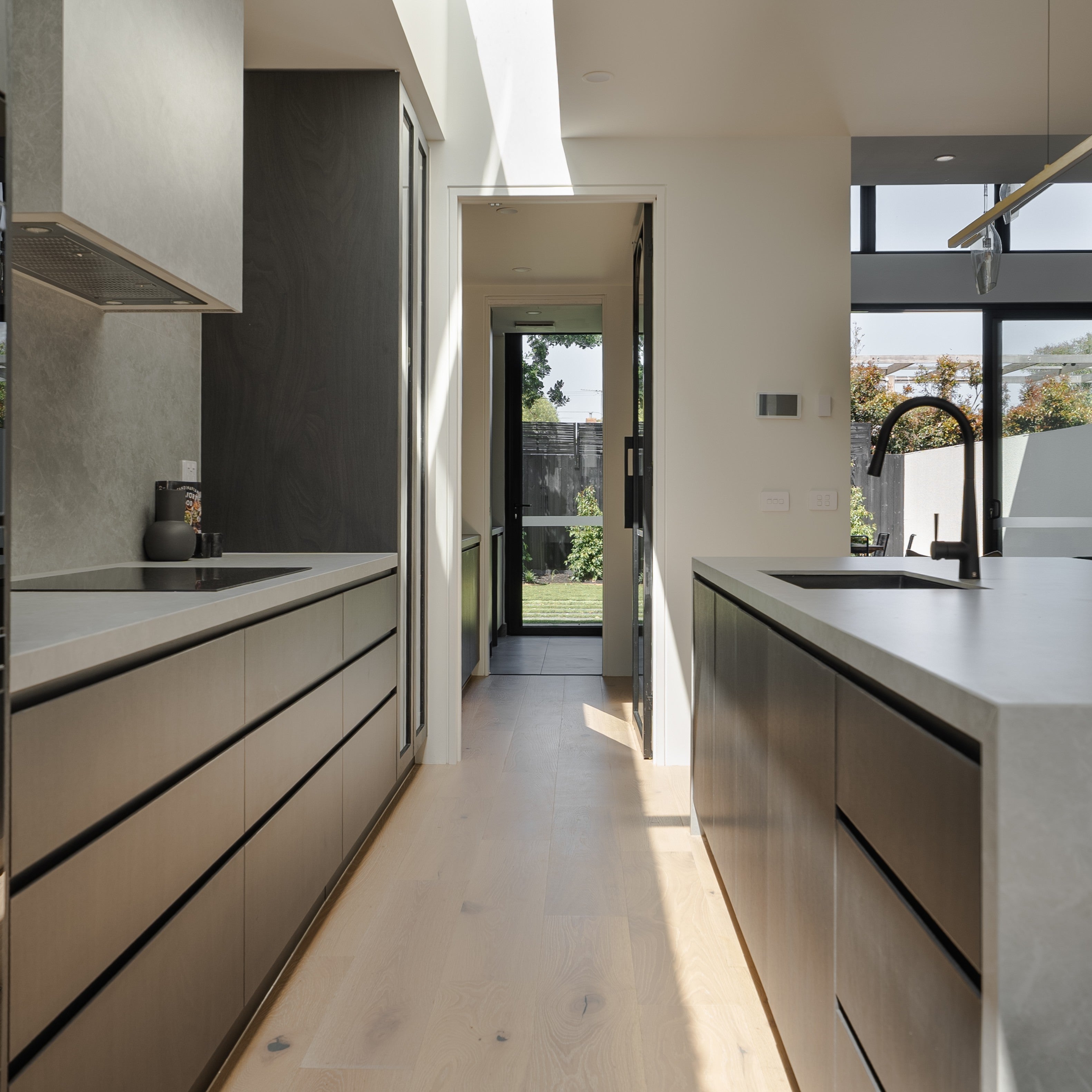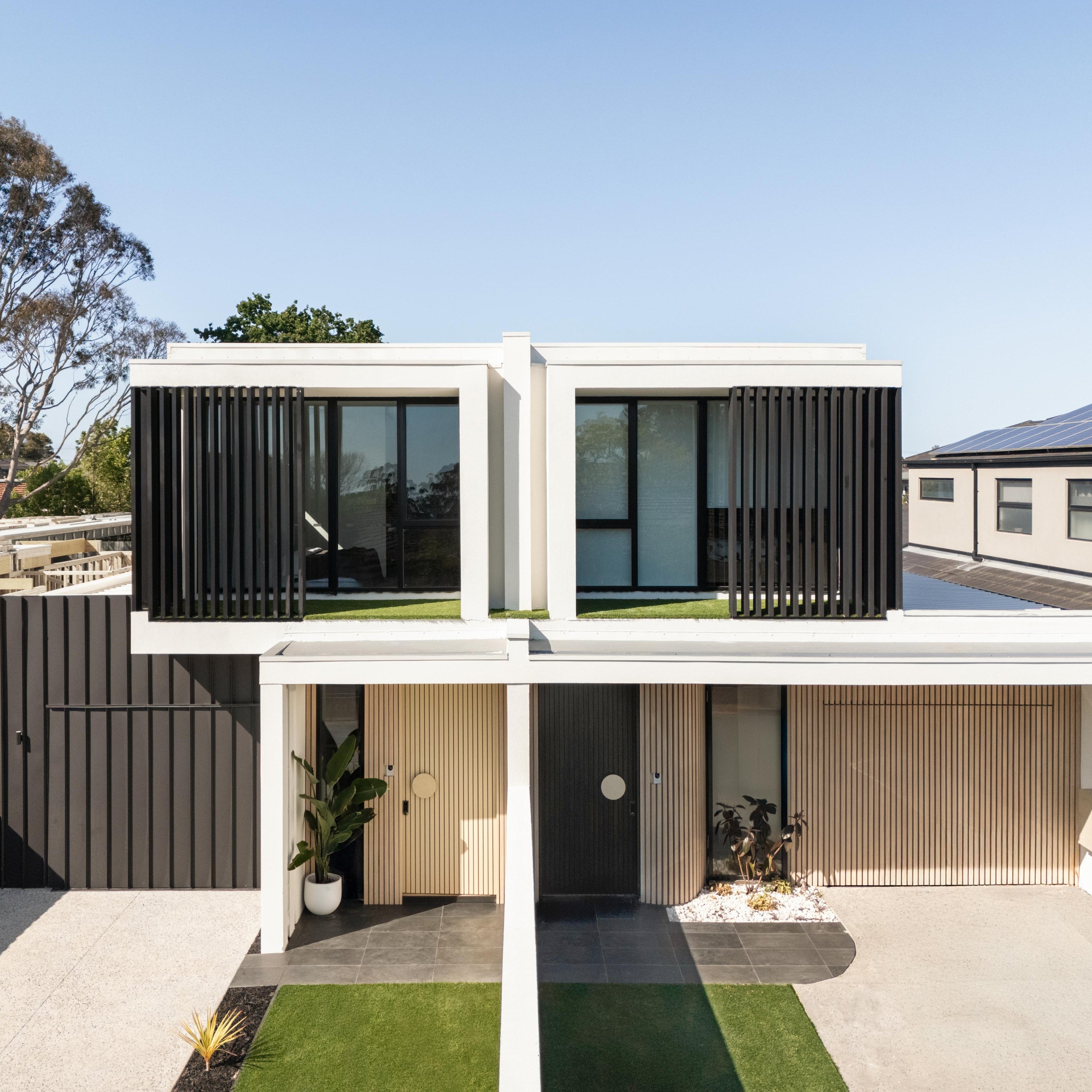Large Porcelain installation guide
|
|
1. Substrate Control
Laying large format tile can be performed on the normal supports present in buildings such as, for example concrete, cementitious screeds, pre-existing radiators ceramic floors, tc.
- Intact and without cracks;
- Seasoned and dimensionally stable;
- Mechanically resistant;
- Dry;
- Clean and free of removable parts;
- Perfectly flat;
The screeds must have the following mechanical strengths compression:
- For residential environments: > 15-20 N / mm2;
- For industrial environments: > 30-40 N / mm2;
2. Handling of Large Format Porcelain
For the handling of large format tiles it is necessary to have at least two operators to use the specific tools.
Wear the personal protective equipment:
|
|
|
|
1.Before Lifting the tile, it needs to be clean. |
2. Adapt the frame to the tile and distribute the suction cups evenly, firm p essure downards whilst closing the cup. Place the rubber feet out of the tile. |
 |
 |
|
3. Lift the tile |
4.Transport the tile (with CARRIAGE KIT if available). |

3.Cutting and Drilling of Tiles

CUTTING: SCORING/SNAPPING
For linear cuts: scoring / snapping use the KERA-CUT cutting rail.
|
|
|
|
|
1. Place the tile on the workbench. |
2. Mark with a pencil where the cut should come on both sides of the tile. |
 |
 |
| 3. Fix the cutting rail on the tile clamping the suctions cups. |
4. Score the end of the tile 3/4cm back from the inside to outside, then score it along its entire length while maintaining a constant pressure. | |
 |
 |
|
5. For snapping the tile you simply move the scored line to the edge of the table, then snap the tile with the appropriate nipper.
|
6.Complete the snap by pressing gently downards.
|
For linear saw cuts it is suffici cutting system
For tile thickness up to 6mm it is recommended to use a continuous row disc, over 6mm is recommended a turbo disk.
Use personal protective equipment:

 |
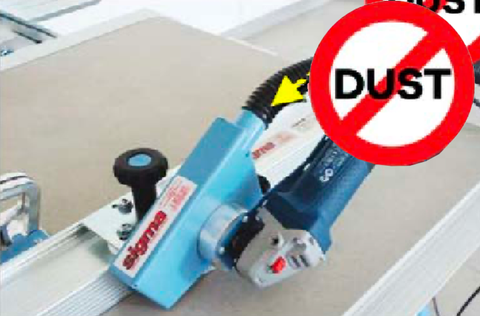 |
|
1. Place the KERA-CUT rail on the tile, remove the scoring carriage and replace it with the KERA-FLEX. |
2. Insert the vacuum cleaner pipe for the total dust extraction. |
 |
 |
|
3. Adjust the cutting depth stop.
|
4. Proceed with cutting the tile.
|
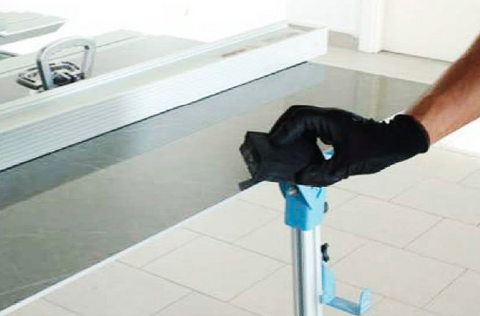 |
 |
|
5. At the end of the process it is possible to clean the cut edge with a finishing diamond pad. |
6. At the end of the process it is possible to clean the cut edge with a finishing diamond grinding wheel. |
DRILLING:
For the execution of rectangular holes or pockets it is important to make four holes (ø minimum 8mm) in each corner to avoid excessive tension to use the Sigma drill bit.
Use personal protective equipment:



 |
 |
|
3. Start the hole by tilting the drill bit.
|
4. Continue drilling with oscillating movement without pushing excessively, cooling the drill bit with water if necessary. |
 |
 |
|
5. For the execution of rectangular holes or pockets is important to make four holes(ø minimum 8mm) in each corner to avoid excessive tension. |
6. Then use a continous crown disc for cutting the sides.
|
TYPES OF CUTTING:
During the processing of the tiles we will be in front of various processes, including linear cuts, “L” cuts, rectangular holes etc.
The cuts can be done thanks:
- Sawn cut (obtained through KERA-FLEX
or manually)
- score/snap cut (obtained through KERACUT)
For every processing there can be many solutions, it is up to the operator to choose which operator, here are some examples.
In case of realizing an “L” shape of the tile is to be made, proceed as follows:
 |
 |
 |
 |
 |
 |
4. Edge Profiling Tiles
For aesthetic or functional reasons, you can achieve finishes such as mi er, bevels or half bullnose. These are easily achieve with the Sigma machines JOLLY-EDGE or SIMPLE- BEVEL that slides along on the edge of the tile and guarantee the uniformity of the
cut/bevel along its length (even if this last is slightly curved), by to the vacuum cleaner pipe they do not generate dust.
Use the individual protective devices:

 |
 |
|
1. For the correct execution of the edge profiling, place the tile on the Sigma WORKBENCH and fix it with the special clamps making it p otude 1/2cm from the edge of the bench.
|
2. For the mitering, move the machine JOLLY-EDGE (in cutting configu ation) from right to the left, keeping it well pressed on the edge of the tile. It can work thicknesses from 5 to 20mm. Thickness 5/7mm with continuous crown disk. 8/20mm thickness with turbo disc.
|
 |
 |
|
3. For the half bullnosing, move the machine JOLLY-EDGE (in “bullnose” configu ation with the shape grinding wheel) from left to right, keeping it well pressed on the edge of the tile. |
4. To achieve bevels/miters on 3.5mm thicknesses, move the SIMPLE-BEVEL machine sideways, keeping it well pressed on the edge of the tile. It is possible to carry out several steps on depth and/or di erent angles. |
5. Laying of Large Format Tiles
In addition to the substrate control as described in chapter 1, the choice of the adhesive depends on the type of support, the tile size and place of installation.
The UNI EN 12004 standard shows
how for the tiles with side equal to or bigger than 60cm is necessary to use
an adhesive of class C2, with class of deformability S1 in case the tile has a side equal to or less than 120cm, and with class S2 if bigger than 120cm.
Depending on the temperature, it is possible to use Classified adhesi es “E” (extended open time) in case of hot climates or ventilated environments, or “F” class adhesives (quick drying) in cold environments. During the wall laying it is recommended to use stickers with limited vertical slip “T” class.
For tiles with side equal to or bigger than 60cm it is necessary to use the double thinnest coverage technique for guarantee no air between support and tile.
 |
 |
|
For thinset coverage on the back of the tile is recommended the use of 4x4mm notch trowel. |
For thinset coverage on the back of
the support is recommended |

 |
 |
|
The application of the adhesive on the tile must take place with direction parallel to its short side, to facilitate the air outflow. |
The application of the adhesive on the substrate must have the same direction of the adhesive on the tile. |
To faciliate the installation of thet ile it is necessary to use the KERA-LIFT handling frame and the following personal protective equipment:

The width of the joints between the slabs is in function of the support, the dimensions of the
tile, the laying destination, etc., but in any case it must not be less than 2mm. It is necessary to use leveling system, positioning about 1 every 50cm.
 |
 |
|
1. Tiling the floor with the handlin frame KERA-LIFT. |
2. During the fixing on the all the support feet of the KERA-LIFT will avoid damage to the tile. |

3. Distribute the levelers and manually hammer the tile using the special “BEAT TILE TROWEL” to ensure complete discharge of air, starting from the center to the sides in the same direction of the thin set.
 |
 |
|
4. Use the “MOVE” to adjust any joint di erence between the tiles. |
5. Tighten the levellers and remove them only after the adhesive has completely cured or set. |
6. Kera-Lift
“KERA-LIFT” frame with suction cups for lifting, handling and laying of large format tiles. Freely adjustable without the use of tools, it is composed from sliding guides to each other to adapt to any shape of the tile.
The suction cups can slide along the profile to adapt to any need.

 |
 |
|
The safety fall brackets can be positioned both on the long side and the short side of the KERA-LIFT, and they are indispensable for working safely in all situations. |
The pump suction cups, stain free and tilting with fl w indicator, also for rough materials. Maximum load 90kg (45kg according to CE standard) |

The feet support of the KERA-LIFT avoid damage to the tile.
7. Carriage Kit
The KERA-LIFT can be equipped with accessories, completely removable, which extend the functionality.
The “CARRIAGE KIT” consists of two wheels, two tile supports to be used during the transport, and two openable pedestral for the thinest of the tile.

 |
 |
 |
|
The CARRIAGE-KIT is fitted before the lifting of the tile. |
Transport with the CARRIAGE KIT | Applying the thin set with the CARRIAGE KIT |
8. Workbench
Demountable and modular “WORKBENCH”, suitable as a support for working large format tiles and ceramic tiles.
Thanks to its aluminum structure, light and sturdy which guarantees excellent support of large format tiles.
The WORKBENCHES can be connected to each other to obtain a single worktop 360cm long.
It is easy to fold in its legs for easy transport minimizing the space.
You can easily fit on the workbench various equipment, such as the KERA-CUT cutting guide, table fixing kit SIMPLE-BEVEL and JOLLY-EDGE etc...
Accessories are available as clamps, hooks to support the KERA-CUT cutting guide, tile rise spacer.

 |
 |
 |
|
Clamps for fixing the tile on the workbench. |
Tile rise spacers for make transversal cuts with diamond disc. | Hooks to support the KERA-CUT cutting guide. |
9. Kera-Cut
The KERA-CUT cutting equipment allows the cutting of large format tiles. The divisible aluminum guide, fi ed on the tile by stain-free suction cups, allows at the carriage to slide with an scoring wheel; then the separation is carried out with the supplied nipper (max 7mm). For transport, the guides and all accessories are contained in two suitcase supplied.

 |
 |
|
Sliding carriage with coated wheels, with double ball bearings. |
Fixing on the tile with anti-stain suction cups, freely positioned. |
 |
 |
 |
| The guides in the lower part are covered with non-slip and stain-free rubber. | Connection of the guides wiht three high precision steel connection joints. | The push with two-handed lever allows a very deep incision. |


Fixing to the working table with swivel support.
10. Kera-Flex
The KERA-FLEX mounted on the KERA-CUT guide allows sawn cut, with diamond blade of up to 30mm.

 |
 |
 |
| Insertion on the KERA-CUT guide. | Easy adjustment of the depth stop. | Universal vacuum cleaner attachment. |

Fixing to the working table with swivel support.
11. Jolly-Edge
JOLLY-EDGE machine for cutting and processing of tiles/slabs, sliding on the edge of the tile (porcelain stoneware, marble, granite, etc.) guarantees the uniformity of the working along the entire length of the edge, copying exactly the natural curves of the tile.
It can work in a single pass tile with a thickness of 5 < 20mm and size from 30cm to infinit .
In the configu ation with diamond disc, allows the execution of miter at any angle between 40O and 50O. In the configu ation with diamond grinding wheel, it allows the execution half bullnose with
radius 6-8-10mm.

 |
 |
|
Miter processing with blade. |
Half Bullnose processing with grinding wheel. |

Example of processing
12. Simple-Bevel
SIMPLE-BEVEL, precision bevel machine of tiles/slabs (porcelain stoneware, granite, marble, glass). Sliding on the edge of the tile, guarantees the uniformity of the bevel along its entire length, copying
exactly the curves of the plate.
Chamfer from 0 <12mm (0 <6mm on porcelain tiles) and size from 30mm to infinit . Adjustable to any angle from 22O to 90O.


 |
 |
|
Beveled Tile |
Jolly on a 3mm tile |
 |
 |
|
Processing on tile 1.Beginning |
2.End |
 |
 |
 |
| Bevel finishing and polishing of tile edge, cut with blade. Angle 220 ÷ 900. Back miter width 1 ÷ 4mm, on gres porcelain material. Using grinding cup art. 72E-72F-72G-72i. | Finishing and polishing of lateral edge on tiles, cut with blade. 2 to 30mm thick tiles. Machining at 900. Using grinding cup art. 72E-72F-72G-72i. | Finishing and polishing of tiles edge, previously chamfered with blade.Angle 220 ÷ 900. Chamfer width: 1÷18mm on gres porcelain material. Using grinding cup art. 72E-72F-72G-72i. |
12. Accessories
Recommended accessories for processing on large tiles:
 |
Fast Drill Bit / Diamond drill bit for dry or wet drilling on Gres Porcelain tile, Marble, Granite, etc... Hexagonal attach 9mm / threaded M14. |
 |
For thinset coverage on the back of the tile is recommended the use of 4x4mm notch trowel. |
 |
For thinset coverage on the back of the support is recommended the use of “NO-AIR” trowel that is specifi ally designed. |
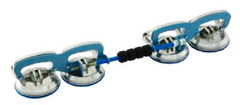 |
MOVE suction cups, indispensable for square approach of large format tiles, thanks to the four stain free cups a strong seal (even on rough materials). |
 |
Turbo blade disc d115 for thicknesses from 10 to 25mm. |
 |
Continuous crown disc ø 115 for thicknesses from 3 to 9mm. Pad with velcro. |
 |
Pad with velvro |
 |
Diamond grinding wheels with velcro available in di erent grits: 50 roughing / 200 finishin / 800 semi-polishing / 1500 polishing. |
 |
120 grit diamond pad for hand finishing |
 |
Separator for pre-scored tiles, recommended for thicknesses bigger than 8mm. |


